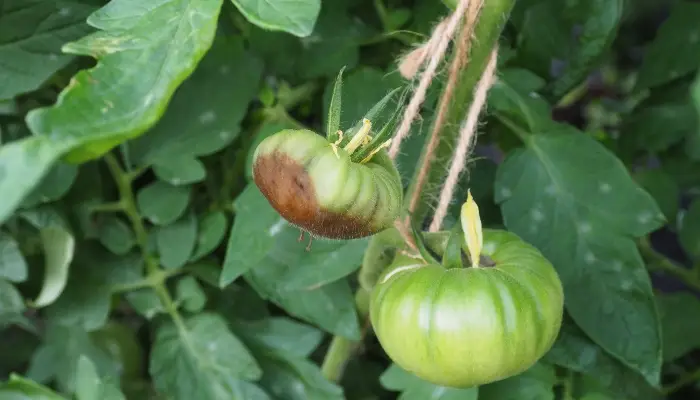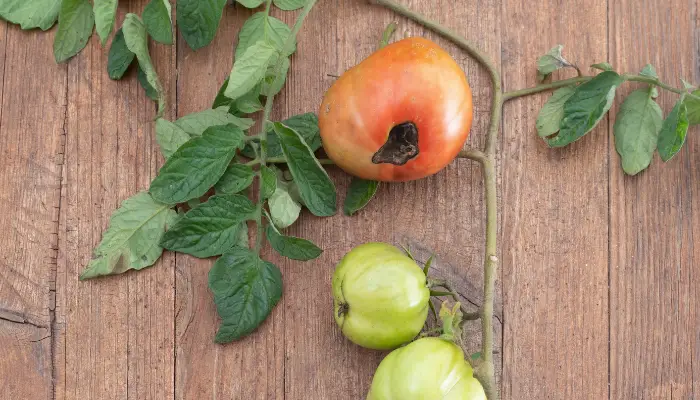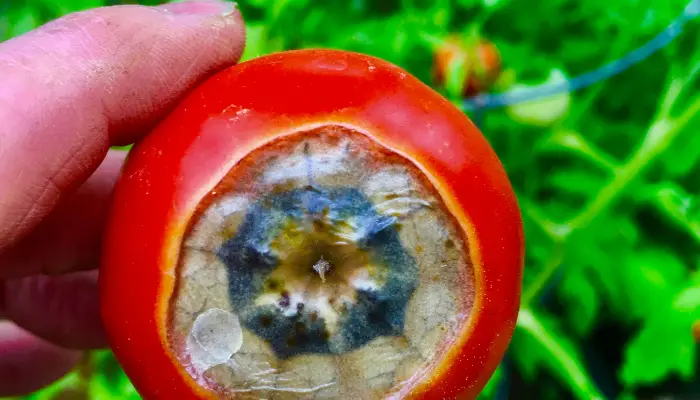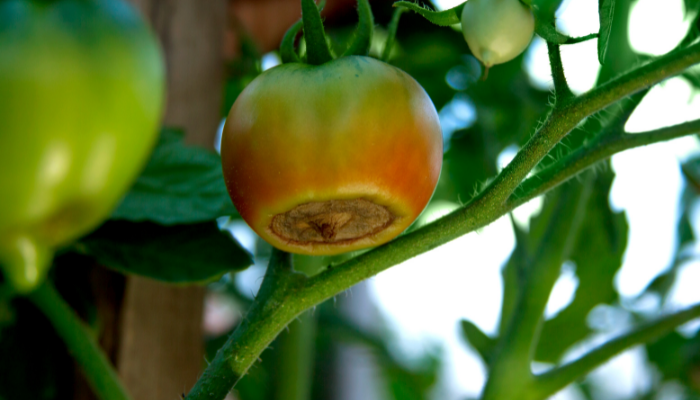Tomato Blossom Rot Treatment: Tips and Tricks to Save Your Harvest
Tomato blossom rot can be a frustrating problem for gardeners. This condition is caused by a lack of calcium in the developing fruit, which results in a dark, sunken spot on the blossom end of the tomato. Fortunately, there are several treatments available to prevent and manage blossom end rot.
One effective treatment for blossom end rot is to maintain consistent soil moisture. Tomatoes require regular watering to prevent the soil from drying out, which can affect calcium uptake. Gardeners should aim to keep the soil evenly moist, but not waterlogged, throughout the growing season. Mulching around the base of the plants can also help to retain moisture and regulate soil temperature.
Another treatment option is to use a calcium supplement. Calcium is essential for healthy tomato growth, and a deficiency can lead to blossom end rot. Gardeners can add calcium to the soil by using a commercial calcium supplement or by applying crushed eggshells or bone meal around the base of the plants. It’s important to note that calcium supplements are most effective when used preventatively, rather than as a treatment for existing blossom end rot.
What is Tomato Blossom Rot?

Tomato blossom rot is a common problem that affects many tomato plants. It is a condition that causes the bottom of the tomato fruit to turn black and become sunken. This condition is caused by a calcium deficiency in the fruit, which leads to the breakdown of the cell walls in the fruit tissue.
Tomatoes require a steady supply of calcium during their growth and development. When the plant is unable to get enough calcium, it causes the fruit to develop blossom end rot. Calcium is essential for the growth and development of the plant cell walls, and a deficiency of calcium can cause the cell walls to break down, leading to the development of blossom end rot.
There are several factors that can contribute to the development of blossom end rot, including:
- Over-fertilization during early fruiting stages
- Inconsistent watering practices
- Soil pH imbalances
- Extreme temperatures
- Poor soil drainage
To prevent the development of blossom end rot, it is important to maintain consistent watering practices and avoid over-fertilization of the plant during early fruiting stages. Additionally, testing the soil pH and ensuring that it is within the optimal range for tomato growth can help prevent the development of blossom end rot.
In some cases, it may be necessary to supplement the plant with calcium to prevent the development of blossom end rot. This can be done by adding calcium-rich fertilizers or by using foliar sprays that contain calcium. By taking these steps, the development of blossom end rot can be prevented, and healthy tomato plants can be grown.
Causes of Tomato Blossom Rot

Tomato blossom rot is a common problem that can affect tomato plants, resulting in disfiguration of developing fruit. Here are some of the most common causes of tomato blossom rot:
Calcium Deficiency
Calcium is an essential nutrient for tomato plants, and a deficiency can lead to blossom rot. When there is not enough calcium available to the plant, the fruit tissue breaks down and results in the characteristic black, sunken spots on the bottom of the tomato.
According to The Spruce, calcium deficiency can be caused by over-fertilization during early fruiting, which can cause the plant to grow too fast and be unable to take up sufficient amounts of calcium to keep up with fruit development. Calcium deficiency can also be caused by improper soil pH, high salt levels in the soil, or damage to the plant’s roots.
Inconsistent Watering
Inconsistent watering can also contribute to blossom rot. When tomato plants receive too little water, they are unable to take up the calcium they need to develop properly. On the other hand, when they receive too much water, the roots can become waterlogged, which can damage the roots and prevent the plant from taking up calcium.
According to The Old Farmer’s Almanac, watering issues can be a cause of calcium deficiency during fruit formation. To prevent blossom-end rot, it is important to ensure that tomato plants receive consistent, even watering.
Poor Soil Drainage
Poor soil drainage can also contribute to blossom rot. When soil is poorly drained, it can become waterlogged, preventing the roots from taking up calcium. This can be especially problematic in heavy clay soils that do not drain well.
To prevent blossom rot caused by poor soil drainage, it is important to ensure that tomato plants are grown in well-draining soil. Adding organic matter to the soil can help improve drainage and prevent waterlogging.
Identifying Tomato Blossom Rot

Tomato blossom rot is a common problem that can affect tomatoes and related members of the nightshade family, such as peppers and eggplants. It is a physiological disorder that is caused by a deficiency of calcium in the fruit. The condition affects the blossom end of the fruit, which is the end opposite the stem. Here are the initial symptoms and progressive signs of tomato blossom rot.
Initial Symptoms
The first sign of tomato blossom rot is a small, water-soaked area on the blossom end of the fruit. This spot is usually circular and slightly sunken. It may be difficult to see at first, but it will gradually grow in size and become more noticeable as the fruit develops. The spot will eventually turn brown or black and become leathery in texture.
Progressive Signs
As the condition progresses, the affected area will become larger and more sunken. The entire blossom end of the fruit may become discolored and dry out. The fruit may also become misshapen and deformed. In severe cases, the affected fruit may rot and fall off the plant.
It is important to note that not all brown spots on tomatoes are caused by blossom end rot. Other conditions, such as sunscald, insect damage, and fungal diseases, can also cause similar symptoms. Therefore, it is important to properly identify the cause of the problem before taking any corrective action.
By being able to identify the initial symptoms and progressive signs of tomato blossom rot, gardeners can take action to prevent the condition from spreading to other plants.
Preventing Tomato Blossom Rot

Tomato blossom rot can be prevented with proper care and attention to the plant’s needs. In this section, we will discuss three key factors that can help prevent blossom rot: soil testing, proper watering techniques, and balanced fertilization.
Soil Testing
Before planting tomatoes, it is important to test the soil to ensure it has the proper pH level and nutrient balance. Soil with a pH level below 6.0 or above 7.0 can lead to nutrient deficiencies and blossom rot. A soil test will also reveal if there is a calcium deficiency in the soil, which is a common cause of blossom rot.
If the soil test reveals a calcium deficiency, the soil can be amended with lime or gypsum to increase the calcium levels. It is important to follow the recommended application rates for these amendments, as over-application can lead to other nutrient imbalances.
Proper Watering Techniques
Proper watering techniques are crucial in preventing blossom rot. Tomato plants require consistent moisture to prevent stress and nutrient imbalances. However, overwatering can lead to waterlogged soil, which can inhibit nutrient uptake and lead to blossom rot.
To prevent overwatering, it is recommended to water tomato plants deeply but infrequently. This means watering the plants thoroughly once or twice a week, depending on the weather conditions. It is also important to water the plants at the base, rather than from above, to prevent water from sitting on the leaves and causing disease.
Balanced Fertilization
Balanced fertilization is another key factor in preventing blossom rot. Tomato plants require a balanced supply of nutrients, including nitrogen, phosphorus, and potassium, as well as micronutrients such as calcium and magnesium.
Over-fertilization can lead to nutrient imbalances and blossom rot, so it is important to follow the recommended application rates for fertilizers. It is also recommended to use a slow-release fertilizer to provide a steady supply of nutrients over time.
By following these tips for soil testing, proper watering techniques, and balanced fertilization, gardeners can help prevent blossom rot and ensure a healthy tomato harvest.
Treatment Methods
Tomato blossom end rot can be treated using several methods. Here are some of the most effective ways to treat it:
Use of Calcium Supplements
Calcium is essential for healthy tomato growth, and a lack of it can lead to blossom end rot. Gardeners can use calcium supplements to treat the condition. Calcium can be applied in several ways, including through foliar sprays, soil applications, and fertigation. Gardeners can also use calcium nitrate or calcium chloride to treat the condition. However, it is essential to follow the manufacturer’s instructions when using calcium supplements.
Adjusting Watering Regime
Blossom end rot can also be caused by inconsistent watering. Gardeners should ensure that their tomato plants receive adequate water. They can do this by watering the plants deeply and regularly. It is also essential to avoid overwatering the plants, as this can lead to other problems such as root rot.
Improving Soil Conditions
Soil conditions can also contribute to blossom end rot. Gardeners should ensure that their soil has adequate calcium levels. They can do this by adding lime to the soil to increase its pH levels. Gardeners can also add organic matter to the soil to improve its nutrient levels. It is essential to test the soil regularly to ensure that it has the right nutrient levels.
In conclusion, tomato blossom end rot can be treated using several methods. Gardeners can use calcium supplements, adjust their watering regime, and improve soil conditions to treat the condition. By following these methods, gardeners can ensure that their tomato plants remain healthy and produce a bountiful harvest.
Post Treatment Care
After treating tomato blossom end rot, it is important to continue caring for the plants to prevent the issue from reoccurring. This section will cover some important post-treatment care tips.
Regular Monitoring
It is important to regularly monitor the plants for any signs of blossom end rot. This can be done by checking the fruit for dark, sunken spots on the blossom end. If any signs are detected, it is important to take action immediately to prevent the issue from spreading.
Continued Soil Management
Maintaining proper soil moisture and nutrient levels is crucial for preventing blossom end rot. Gardeners should continue to monitor the soil moisture levels and water the plants as needed. It is also important to ensure that the soil has adequate calcium levels. This can be achieved through the use of calcium-rich fertilizers or amendments.
Additionally, gardeners should avoid over-fertilizing with nitrogen, as this can lead to calcium deficiency in the plant. Deep cultivation around the plants should also be avoided, especially during dry weather, as this can damage the plant’s roots and reduce its ability to take up nutrients.
By following these post-treatment care tips, gardeners can help prevent blossom end rot from reoccurring and ensure a healthy tomato harvest.
Frequently Asked Questions
How can I prevent blossom end rot on my tomatoes?
Preventing blossom end rot involves ensuring that the plants have sufficient calcium and consistent moisture levels. Gardeners can add calcium to the soil by applying crushed eggshells, bone meal, or agricultural lime. They can also maintain consistent moisture levels by watering the plants deeply and regularly, but not too frequently. Mulching around the plants can also help to retain moisture in the soil.
What are some effective treatments for blossom end rot?
One effective treatment for blossom end rot is to apply a calcium solution directly to the affected plants. This can be achieved by mixing a tablespoon of calcium chloride or calcium nitrate with a gallon of water and applying it to the plants. Another treatment option is to remove the affected fruits and dispose of them, allowing the plant to focus on developing healthy new fruit.
Is there a specific calcium solution that can help with blossom end rot?
Calcium chloride and calcium nitrate are two common calcium solutions that can help to treat blossom end rot. Both are readily available at most garden centers and can be mixed with water and applied directly to the affected plants.
Why are my tomatoes rotting before they ripen?
Tomatoes may begin to rot before they ripen due to a variety of factors, including inconsistent watering, poor soil quality, or disease. It is important to identify the underlying cause of the rot in order to effectively treat the problem.
Can lime be used to treat blossom end rot on tomatoes?
Lime is not an effective treatment for blossom end rot on tomatoes. While it can help to raise the pH of the soil and improve nutrient availability, it does not provide the readily available calcium that is necessary to treat blossom end rot.
Is it safe to eat tomatoes with blossom end rot?
While tomatoes with blossom end rot are safe to eat, the affected portion of the fruit should be removed before consumption. The remaining portion of the fruit is still edible and nutritious.








